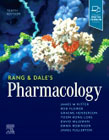
Rang & Dales Pharmacology
Ritter, James M.
Flower, Rod J.
Henderson, Graeme
Loke, Yoon Kong
MacEwan, David
Robinson, Emma
Fullerton, James
Rang and Dale's Pharmacology is internationally acknowledged as the core textbook for students of pharmacology, and has provided accessible, up-to-date information on drugs and their mechanism of action for more than 30 years. Now in its tenth edition, it has been updated to include important new drugs such as gene therapies, personalised medicines and the new wave of RNA drugs. However it has not lost any of the elements that have contributed to its popularity, such as color coding and illustrations, making it reader-friendly while comprehensively covering the depth of detail required. This essential book is recommended as the first-choice undergraduate text for science and medical students and junior doctors and will also be useful for students in other professional disciplines such as pharmacy, veterinary medicine and nursing. INDICE: Section 1 GENERAL PRINCIPLES1. What is pharmacology?2. How drugs act: general principles3. How drugs act: molecular aspects4. How drugs act: cellular aspects - excitation, contraction and secretion5. How drugs act: Biopharmaceuticals and gene therapy6. Cell proliferation, apoptosis, repair and regeneration7. Cellular mechanisms: host defence8. Method and measurement in pharmacology9. Absorption and distribution of drugs10. Drug metabolism and elimination11. Pharmacokinetics12. Individual variation, pharmacogenomics and personalised medicineSection 2 CHEMICAL MEDIATORS13. Chemical mediators and the autonomic nervous system14. Cholinergic transmission15. Noradrenergic transmission16. 5-Hydroxytryptamine and purines17. Histamine and the biologically active lipids18. Cannabinoids19. Nitric oxide and related mediatorsSection 3 DRUGS AFFECTING MAJOR ORGAN SYSTEMS20. The heart21. The vascular system22. Atherosclerosis and lipoprotein metabolism23. Haemostasis and thrombosis24. Haemopoietic system and treatment of anaemia25. Anti-inflammatory and immunosuppressant drugs26. Skin27. Eye28. Respiratory system29. The kidney and urinary system30. The gastrointestinal tract31. The control of blood glucose and drug treatment of diabetes mellitus32. Obesity33. The pituitary and the adrenal cortex34. Thyroid35. The reproductive system36. Bone metabolismSection 4 NERVOUS SYSTEM37. Chemical transmission and drug action in the central nervous system38. Amino acid transmitters39. Other transmitters and modulators40. Neurodegenerative diseases41. General anaesthetic agents42. Headache43. Analgesic drugs44. Local anaesthetics and other drugs affecting sodium channels45. Anxiolytic and hypnotic drugs46. Antiepileptic drugs47. Antipsychotic drugs48. Antidepressant drugs49. Psychoactive drugs50. Drug abuse and dependenceSection 5 DRUGS USED FOR THE TREATMENT OF INFECTIONS AND CANCER51. Basic principles of antimicrobial chemotherapy52. Antibacterial drugs53. Antiviral drugs54. Antifungal drugs55. Antiprotozoal drugs56. Antihelminthic drugs57. Anticancer drugsSection 6 SPECIAL TOPICS58. Harmful effects of drugs59. Lifestyle drugs and drugs in sport60. Drug discovery and development
- ISBN: 978-0-323-87395-6
- Editorial: Elsevier
- Encuadernacion: Rústica
- Páginas: 808
- Fecha Publicación: 17/04/2023
- Nº Volúmenes: 1
- Idioma: Inglés
